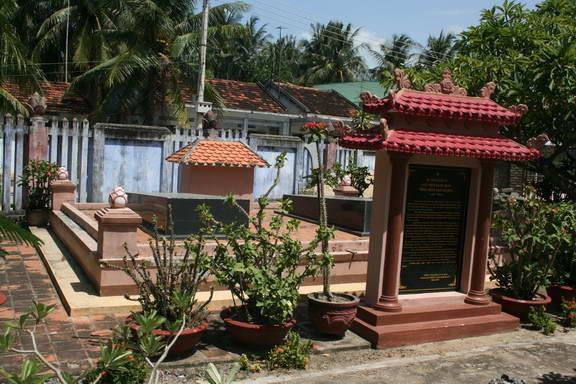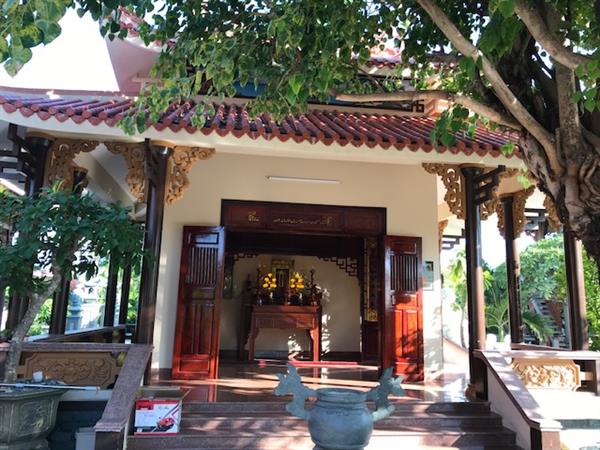Description
The relic is located at Quarter 14, Van Gia town, Van Ninh district, Khanh Hoa province, 60km north of Nha Trang city.
The relic is a memorial place to commemorate Governor Tran Duong, a typical historical figure in Khanh Hoa during the Can Vuong movement against the French at the end of the 19th century. Historical monuments commemorating the famous Tran Duong include the tomb and the temple of the famous Tran Duong located in the campus of Luong Hai pagoda.
Biography of famous person Tran Duong:
Tran Duong Governorate was born in the Year of the Pig (1839), hometown of Hien Luong village, Van Luong commune, Van Ninh district (now in Quarter 14, Van Gia town, Van Ninh district). He is a man of Chinese literature, good at martial arts, and used to be an official under King Tu Duc.
In September 1858, the sound of French colonial guns exploding in Da Nang aroused hatred for the invaders throughout the country. In many localities, the people rebelled against the war. In 1884, the feudal court of the Nguyen Dynasty signed the Treaty of Patenotre accepting the protection of France. However, within the Nguyen dynasty, there was still a part of mandarins with anti-French ideology, the warring faction led by Ton That Thuyet supported King Ham Nghi to ascend to the throne (1885), organized a counterattack against the French in the capital. Hue citadel. The counterattack failed, Ton That Thuyet supported King Ham Nghi to go to Quang Tri to come down to Can Vuong (July 13, 1885) to call on scholars, literary figures and the whole country to support the king to save the country.
Against that historical background, in Khanh Hoa, Tran Duong along with Trinh Phong, Nguyen Khanh, Le Nghi, Pham Chanh, Nguyen Di, Nguyen Luong, Nguyen Sum, Pham Long, and Nguyen Trung Muu were distinguished heroes. established "Binh Tay to save the National Union" with the slogan: "Little bandits except for peace and rebellion; Hung Binh responded to the rebellion, called on the people to join the insurgent army, contribute food, train soldiers, forge weapons to be ready to fight against the invading French colonialists.
He was appointed Governor, in charge of the northern region of Khanh Hoa, assumed the role of Deputy General for Binh Tay General Trinh Phong, based his headquarters at Mount Putu.
Based on the terrain bordering the sea and dividing mountains, creating a dangerous position, the leader of the movement set up a defense system for the sea mouth in Nha Trang, Trai Thuy hill, Ro Tuong, Hon Khoi, Doc Thi, Tu. Cotton, ready to repel the landings from the sea by the French. Facing the spirit of the insurgent army, especially the prestige of the leaders, the top mandarins of the province who were in charge of the Dien Khanh Citadel took the initiative to hand over the Citadel and the right of the army to the insurgents, and Thanh Dien Khanh became the Headquarters. . The Can Vuong movement in Khanh Hoa has been actively supported by people from all walks of life in terms of food and food, mobilizing young people to join the insurgent army to prepare for a long-term resistance.
In 1885, the French used warships to capture Khanh Hoa, Trinh Phong directly commanded and assigned Thanh Dien Khanh to Le Nghi to keep. The French army was blocked by the insurgents in many battles at the mouth of Cu Huan river, Hon Thom, Hon Da Lo, Dien Khanh citadel, Lo Ngo, Nuoc Trong, Hon Mot, and Banh It pass, which consumed the enemy's life force. But with the advantage of modern weapons of the invading army, the French army captured Dien Khanh citadel.
After the fall of Dien Khanh citadel, in order to preserve Trinh Phong's forces, he sent troops to the North together with the forces of the Governor Tran Duong to set up defenses to keep the sea mouths of Hon Khoi, Van Gia, Tu Bong, and build bases. at Hon Heo and Thung Nha Bui (Na Bui). The French used warships to attack Hon Khoi, the insurgents had to withdraw to Hon Heo and Thung Nha Bui (Na Bui) bases to organize defense and continue the fight.
The French resistance war lasted for more than a year but did not destroy the insurgents. They tried to seduce and bribe Tran Duong, Trinh Phong and his martyrs, but could not shake their patriotism and heroic spirit. Many fierce battles between the French and the insurgents such as the ambush battle at Doc Thi (Van Ninh), the battle of scattering blind fruit at Banh It pass (Ninh Hoa), the ambush at Cay Gao wharf (on the Lot river). , Ninh Trung Commune, Ninh Hoa) caused heavy damage to the enemy.
By mid-1886, the French army increased reinforcements from Gia Dinh, by all means destroyed the resistance forces in Khanh Hoa. They organized large sweeps to ravage villages, kill innocent people, use their henchmen to guide the way to destroy the base of the insurgents.
After using all means but still could not destroy the leader of the movement, the French colonialists and henchmen dragged to Hien Luong village to burn all the houses and arrest the men, women, and children in the village and the entire family of Governor Tran. Road to intimidation. Faced with the above situation, with the mettle of an upright man, hero Tran Duong came to surrender himself to the enemy, unable to entice him to surrender, the French colonialists cut off his head in the market for three days, then brought it back to his hometown to bury him. store.
Grave Area:


(Tomb of the famous Tran Duong - Photo: TTBTDT)
In 1886, after he was executed by the French colonialists, the people brought him to the village to bury him, at first the grave was only surrounded by stones. In 1964, the family of Governor Tran Duong embellished the tomb and built a wall around it. In 2002, the tomb continued to be embellished. In 2019, Khanh Hoa province restored the spacious, clean and beautiful tomb area as it is today.
The tomb area consists of two tombs with the same design, according to legend, one burial for the head and one for the body (when Governor Tran Duong was executed by the French colonialists, the body was brought back to be buried first, the head was removed from the body). The French people put them on the market and then they brought them back to be buried later). The rectangular tomb (1.2m wide and 2.6m long) is completely covered with black stone, the floor is paved with red granite, the stele has the inscription Quoc Ngu: "Tomb of TRAN DONG TOGETHER (1839-1886)".
Temple of the famous Tran Duong:

(Temple of the famous Tran Duong - Photo: Nguyen Chi Khai)
In 2019, Khanh Hoa province built a temple to pay tribute and remember the merits of the famous Governor Tran Duong. The temple is designed with a space, surrounded by a system of corridors. The floor is paved with red granite, the roof consists of two floors and eight roofs, roofed with yin and yang tiles; The roof bank has an ancient floor and embossed embossed with the symbol "Two dragons adoring the moon"; the four ancient walls are decorated with paintings of the landscape of his hometown where he was born; decorative embossed embossed strip of “Hoi Long”; Two gable walls embossed with the mascot "Tiger".
The interior of the central temple is the altar of Governor Tran Duong, consisting of 2 wooden altars with carved patterns, on the table are wooden tablets engraved with the words: "高考字陳堂之位" "Cao Cao Tu Tran Duong chi" “vi” means the altar of worship of Mr. Tran Duong.
To the right of the altar is a wooden board introducing the biography, background and career of Governor Tran Duong. In front of the altar is a wooden hammock door, carved with a daisy pattern. On the hammock door is a non-wooden diaphragm with the words: "祠 公 陳", "Tran Cong Tu" which means the temple of Mr. Tran (Tran Duong). The two sides of the hammock door are a couple of wooden couplets carved with patterns, painted in gold with the content:
Spelling:
Bio-General, loyalist and mean-spirited,
The horoscope of the holy glorified spirit.
Year of the Dog Year of the Dog. Ten vows of sand created
Translate:
When he lived as a general, he was worthy of being loyal and loyal
When he died as a god, he became a heroic spirit again.
Created on auspicious day, October of the year of the Dog (2018)
Every year, on the 10th day of June (lunar calendar) of the Tran family, the Executive Board of Luong Hai Pagoda and the local people hold a ceremony to honor the death anniversary of Governor Tran Duong to pay tribute to him.
Although the movement failed, his heroic fighting spirit and noble sacrifice left in the hearts of the people of Khanh Hoa a particularly deep affection. People have honored the three leaders of the Can Vuong movement in Khanh Hoa as "Khanh Hoa three masterpieces" with respect and pride.
Khanh Hoa has three men
Mr. Tran Duong holds Doc Thi pass
Mr. Trinh Phong defends the Cu sea
Mr. Nguyen Khanh takes care of military supplies
His father had a belly, thousands of famous traditions.
With the above typical values, the relic has been issued by the Khanh Hoa Provincial People's Committee Decision No. 522/QD-CT.UBND, dated March 13, 2020 ranked as a provincial historical - cultural relic.